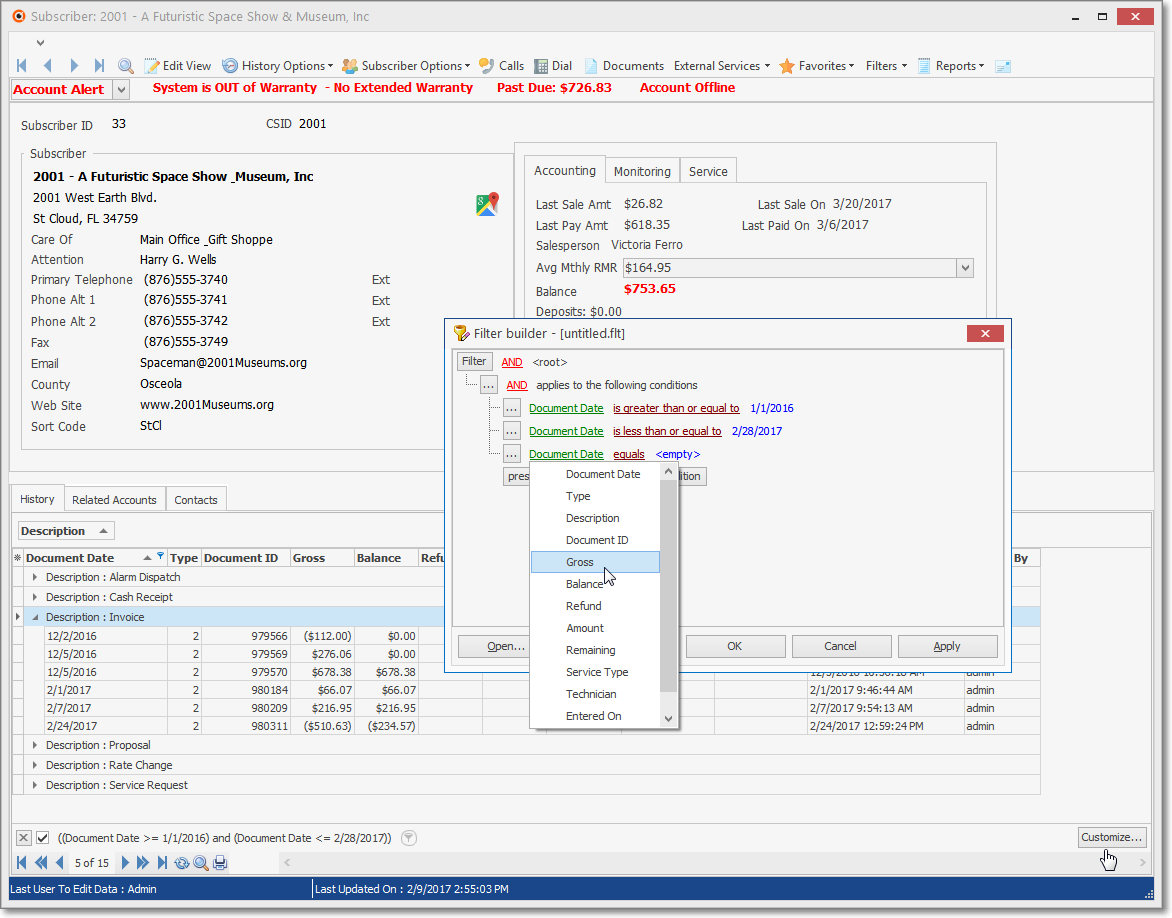❑Anytime a Subscribers Form is open, Click the History Options Icon on the Navigation section of its Ribbon Menu to display the History Options Menu.
•A History Grid (and when appropriate, a Related Accounts Grid) displays a tabular style listing at the bottom for the Subscribers Form
•Each User is able to customize the contents of the History Grid to include:
✓Filter - Sat a Filter: All - or the option to pick one - of the various Types of Data Entries and Financial Transactions which have been entered for the currently selected Subscriber.
✓History - Set a Date Range: Set the Time Frame within which the selected item(s) were posted
✓Hide Grid / Show Grid - Hide or Show the History Grid (and if appropriate, the Related Accounts Grid).
•The History Grid provides a complete and immediate tabular Data Grid of Accounting Transactions (Sales, Receipts, Credits, and Rate Increases), plus records for the Calls, Proposals, Work Orders, and Emailed Invoices created for this Subscriber.
a)Click and Drag the 5 Dot Icon up, or down to increase or decrease the vertical size of the History Grid.
b)Double-Click the 5 Dot Icon to display the History Grid as a full screen presentation.
c)Double-Click the 5 Dot Icon again to return it to its previously set position.
![]()
❖See the "Understanding the Power of the Subscribers Form History Grid" discussion below for more detailed information.
❑Understanding the History Options Menu
•The three History Options are:
1. Filter - Choose this Grid Option to display a Drop-Down Selection List of the available History Grid Data Filtering options
✓This will identify the type of transactional and data entry History which is to be included in the Grid.
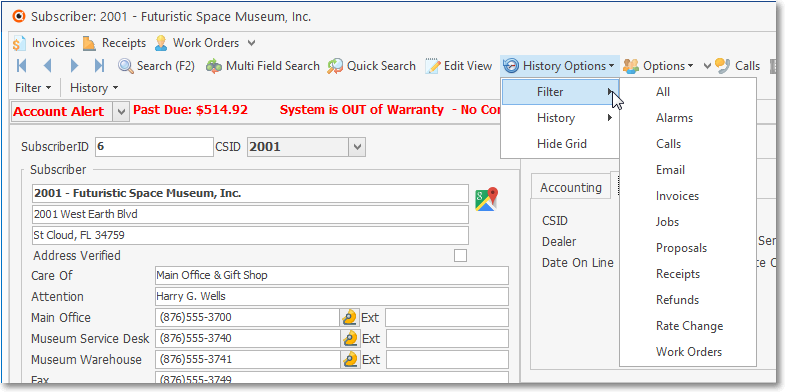
a.By default, All of the available Data (within the Data Types listed above) will be included in the Grid.
b.However, the User may Select a specific Type of Data to be included in the Grid.
c.Double-Click any record listed in the History Grid to view that original record's Form.
2. History - Once the Grid Data Filtering option has been chosen, the Time Frame in which the chosen History Grid Data was entered may be specified.
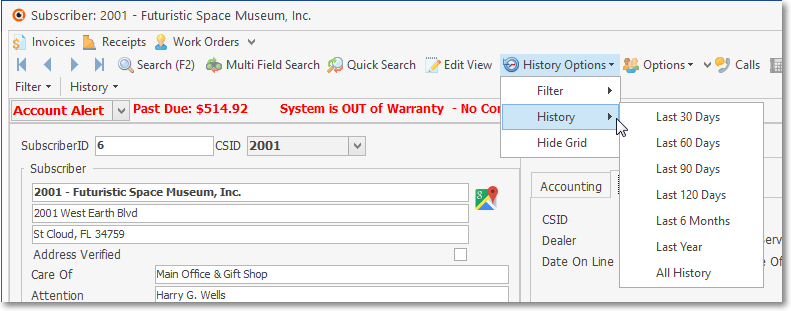
a.The is no default Time Frame.
b.Use the Drop-Down Selection List that displays the available Time Frames from which to Choose.
c.Consider the practical limitations of the number of records which can be effectively viewed and/or analyzed.
d.Setting the SaveSubscriberHistorySetting option to True ("T") in the Company Settings dialog will cause the system to save each User's History Options History setting as they prefer it.

Subscribers Form - History Grid - History tab
e.Related Accounts tab - When a separate Bill Payer has been identified for the currently selected Subscriber , this tab lists that Bill Payer and all Related Accounts (i.e., All Accounts that are billed to the Bill Payer record).

Subscribers Form - History Grid - Related Accounts tab
f.Contacts tab - The Contacts tab will list all Contacts records which have been associated with this Subscriber.

Subscribers Form - History Grid - Contacts tab
3. Hide Grid - Turning the History Grid feature On and Off.
▪Hide Grid - Select the Hide Grid option to remove the History Grid from the Subscribers Form.
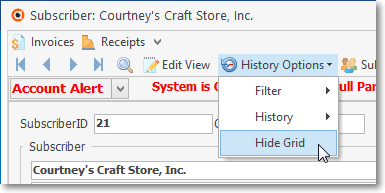
▪Display the Grid - Select the Show Grid option to display the History Grid on the Subscribers Form.
▪Double-Click any record listed in the History Grid to view that original record's Form.
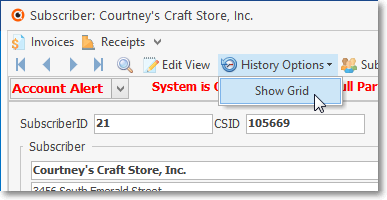
❑Understanding the Power of the Subscribers Form History Grid - This Grid (a sample of which is shown below) offers several ways to manipulate the Grid Data
•After the Grid is Hidden, when it is redisplayed (by selecting the Show Grid option), the Grid's position on the Subscribers Form will return to its last location.
![]()
a)Click and Drag the 5 Dot Icon up, or down to increase or decrease the vertical size of the History Grid.
b)Double-Click the 5 Dot Icon to display the History Grid as a full screen presentation.
c)Double-Click the 5 Dot Icon again to return it to its previously set position.

•Choosing which Columns will be displayed
Ø In the List View, you may Click the Asterisk at the left of the row of Header Names to display a Drop-Down Check List of each column's Headed Name.
✓Check any Header Name to be included in the List View (by default, All Header Names will be Checked)
✓Remove the Check for any Header Name (see illustration below) that is to be removed from the List View.
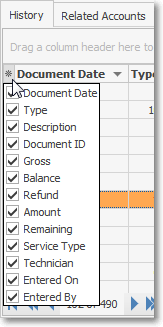
History Grid - Available Columns
•Setting the Order in which the History Grid Data is Listed
✓The sorted order of the Grid is, by default, the Document Date listed from newest to oldest.
▪Click the Header Name (i.e., "Document Date") to change this sorted order to oldest to newest, and Click it again to return it to newest to oldest.
✓However, the column that determines the sorted order in which the data is listed may be easily changed, as needed.
▪Click another column's Header Name to change the sorted order to that column, with the sorted order automatically set from lowest to highest (a-z or 1 - 9).
▪To change this sorted order from highest to lowest, Click that column's Header Name again.
✓Print - Displays the special Print Preview dialog configured as the List View is currently displayed.
•Opening the associated Document - Double-Click on any Detail Line Item to display the Form associated with that History entry.
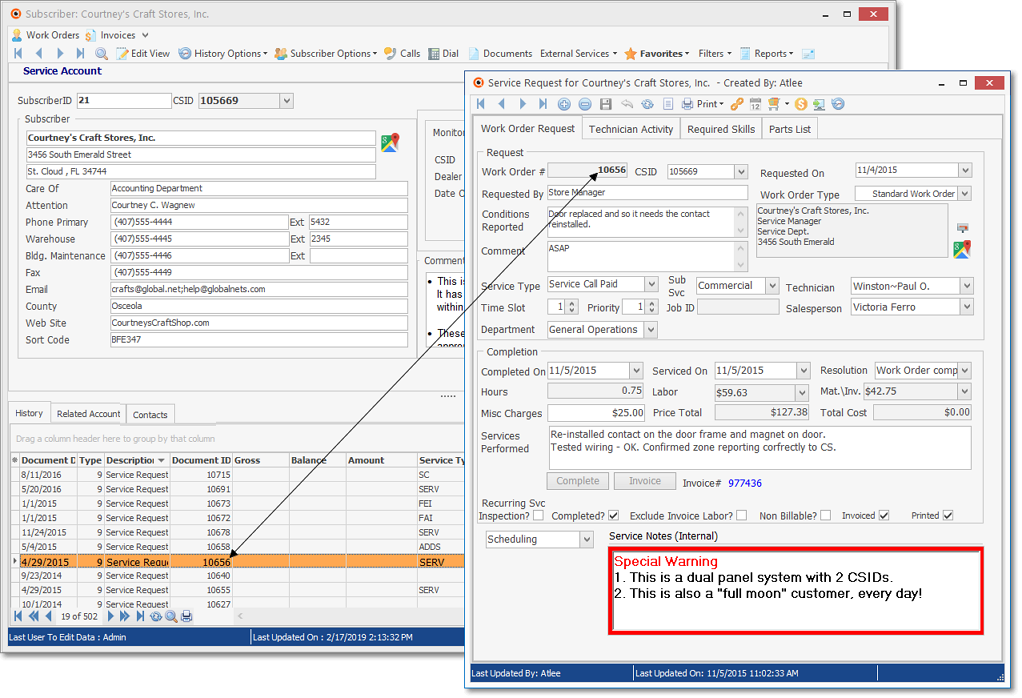
•Printing the History Grid - Click the Print Icon ![]() to display the Print Preview dialog
to display the Print Preview dialog
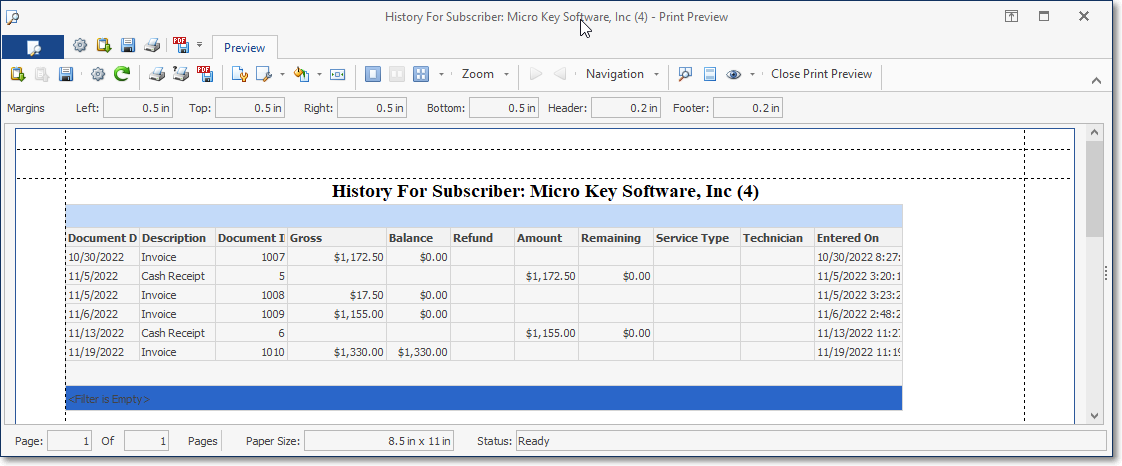
History tab - Print Preview
✓See the Understanding the Print Preview chapter for more detailed information.
•Grouping the List - Grid Data may be separated into Groups based on a selected column's Header Name.
✓Click the Header Name (i.e., "Description" in the illustration below) and Drag that Header Name to the "Drag a column header here to group by that column" message area at the top of the Grid.
✓The Grid Data will be sorted by that Header Name and each unique example of that Header Name will be listed but the contents of each Group will be concealed.
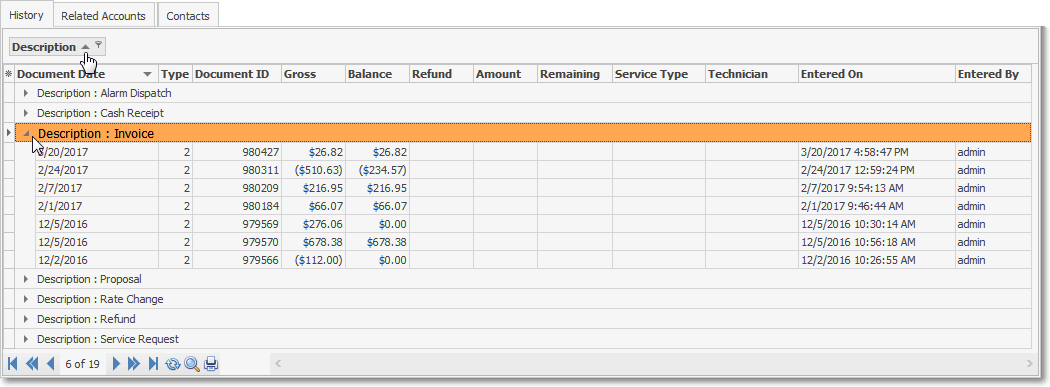
•Viewing each Group's Grid Data - Once a Grid has been sorted into Groups, each Group's Data may be displayed by Clicking the special Arrow to the left of a specific Group Name.
✓The mouse pointer in the illustration above shows the small Arrow to the left of the "Description:Cash Receipt" Group.
▪In the illustration above, the Group Description of Invoice orders the Document column from lowest to highest - in this case, the Invoice Number is the Document's type.
•Sorting each Group's Grid Data Detail
✓Once a Group's Grid Data Detail has been displayed, the sorted order of the Grid Data Detail may be reset by the User by Clicking the Header Name representing the desired sort order.
▪The sorted order of the Invoice Numbers may be reversed by Clicking the Document column (see the mouse pointer above).
▪To change this sorted order of the Grid Data Detail from highest to lowest, back to lowest to highest, Click that column's Header Name again.
•Limiting the specific Group(s) to be displayed, and/or the specific Grid Data Detail Items that are displayed, using the Special Selection Icon - ![]()
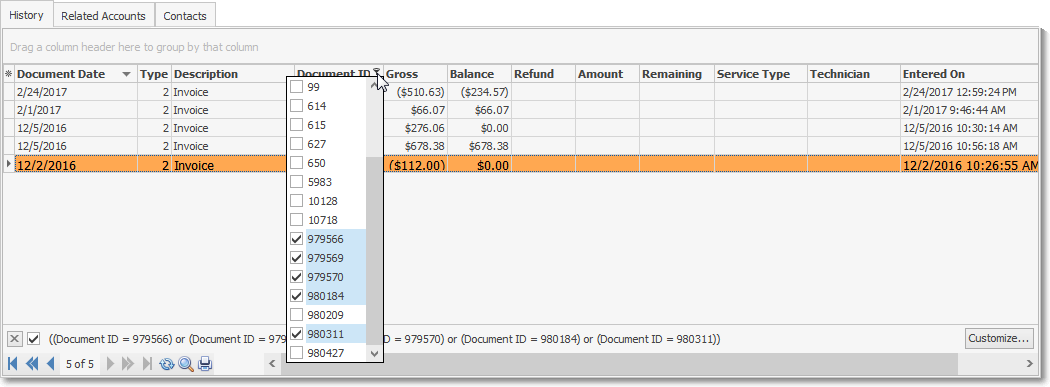
✓Click the Special Selection Icon associated with that column's Header Name (or Group's Name) to display its Drop-Down Selection List
▪The List will contain the available options for that specific column's Header Name (or Group's Name)
▪In the example above, the Document column contains the available items and a Check Box is positioned next to each item
✓Check each item that is to be included.
✓The un-checked items will disappear.
❑Creating a Custom Filter for the Grid, a Group, and/or Grid Data Detail
•Sometimes the User may need a more refined method to Chose which Data Entries and/or Financial Transactions will be included in the Subscribers Form's History Grid.
✓To accommodate this need, the Special Selection Icon's Drop-Down Selection List - described above - also has a "(Custom...)" option.
✓This Custom Filter option is available whenever the Special Selection Icon is displayed - which is anytime the mouse pointer is positioned over a Header Name in the Grid - by Clicking that Icon and then Choosing the (Custom...) option.
•When the Custom Filter option is selected, the Custom Filter dialog is displayed.
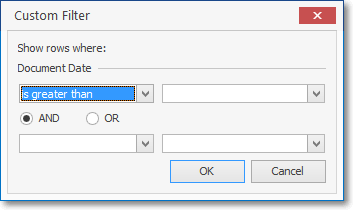
✓The first filtering choice is "Show rows where" with the selected Header Name shown.
•To define this initial filtering criteria, the User is requested to quantify how the selected column's data should compare to a value (or a different field) in one or two situations (e.g., one comparison or an and/or comparison).
✓Using the illustration below as a training example, let's assume the User needs to see Documents dated from 01/01/2014 through 06/30/2014 (the first half of that year)
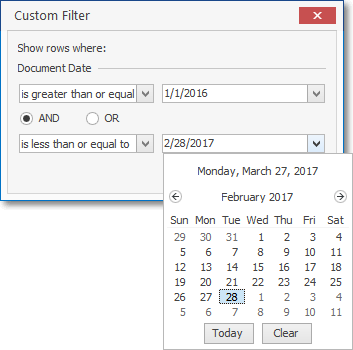
▪Using the first Drop-Down Selection List the User would choose the first "comparative" phrase from the list provided.
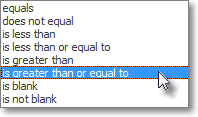
▪Then, the User would enter the value to be compared, and because the system knows it will be a Document's Date, it offers a Drop-Down Calendar/Date Entry field from which a Date may be chosen.
▪Next, the AND button is selected (by default) - but this may be changed, if appropriate; or ignored if no additional comparison is needed (e.g., any Document Dated after 01/01/2015 would be acceptable)
▪Assuming a comparison is needed (it wold be in this case), use the second Drop-Down Selection List to choose the other "comparative" phrase from the list provided.
▪Finally, the User would enter the other value to be compared, and because the system knows it too will be a Document's Date, it offers a Drop-Down Calendar/Date Entry field from which a Date may be chosen.

✓Click OK and the Custom Filter is implemented.
•When a Custom Filter is active, that Filter Criteria is displayed at the bottom of the Grid.
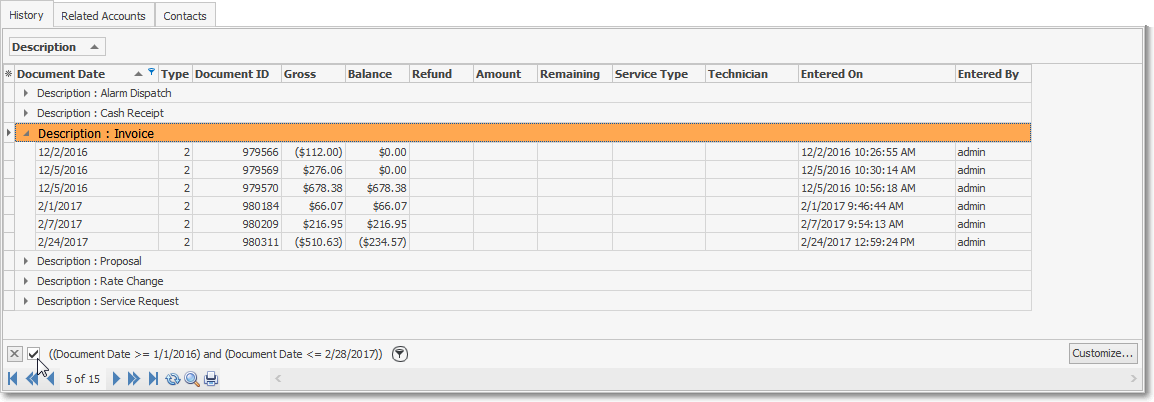
✓The User may Check and un-check the Filter Criteria box to quickly see the data differences when the filter is active, or inactive

✓To Cancel the Custom Filter, Click the Close box on the left side of the Filter Criteria line.
•Enhancing the Custom Filter:
✓Once defined, a Custom Filter may be further refined by Clicking the "Customize..." button at the bottom right of the Grid (which only appears if a Custom Filter is active - see arrow in the illustration below).
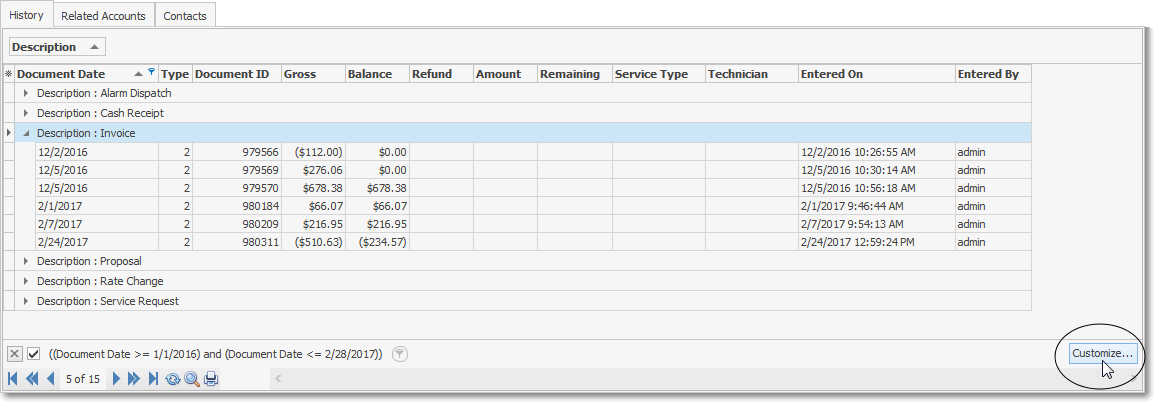
✓The Filter Builder dialog will be displayed with the original Custom Filter information already inserted.
